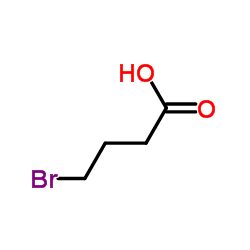406-81-5
| Name | 4-Bromo-1,1,1-trifluorobutane |
|---|---|
| Synonyms |
MFCD00066335
4-Bromo-1,1,1-trifluorobutane 1-Bromo-4,4,4-trifluorobutane Butane, 4-bromo-1,1,1-trifluoro- |
| Density | 1.5±0.1 g/cm3 |
|---|---|
| Boiling Point | 95.7±8.0 °C at 760 mmHg |
| Molecular Formula | C4H6BrF3 |
| Molecular Weight | 190.990 |
| Flash Point | -0.7±14.3 °C |
| Exact Mass | 189.960495 |
| LogP | 2.19 |
| Vapour Pressure | 51.4±0.2 mmHg at 25°C |
| Index of Refraction | 1.380 |
Synonym:4,4,4-Trifluorobutyl bromid Section 2 - COMPOSITION, INFORMATION ON INGREDIENTS
Risk Phrases: 36/37/38 Section 3 - HAZARDS IDENTIFICATION EMERGENCY OVERVIEW
Irritating to eyes, respiratory system and skin. Potential Health Effects Eye: Causes eye irritation. Skin: Causes skin irritation. May be harmful if absorbed through the skin. Ingestion: May cause irritation of the digestive tract. May be harmful if swallowed. Inhalation: Causes respiratory tract irritation. May be harmful if inhaled. Chronic: Not available. Section 4 - FIRST AID MEASURES Eyes: Flush eyes with plenty of water for at least 15 minutes, occasionally lifting the upper and lower eyelids. Get medical aid. Skin: Get medical aid. Flush skin with plenty of water for at least 15 minutes while removing contaminated clothing and shoes. Ingestion: Get medical aid. Wash mouth out with water. Inhalation: Remove from exposure and move to fresh air immediately. If not breathing, give artificial respiration. If breathing is difficult, give oxygen. Get medical aid. Notes to Physician: Treat symptomatically and supportively. Section 5 - FIRE FIGHTING MEASURES General Information: As in any fire, wear a self-contained breathing apparatus in pressure-demand, MSHA/NIOSH (approved or equivalent), and full protective gear. Extinguishing Media: Use water spray, dry chemical, carbon dioxide, or chemical foam. Section 6 - ACCIDENTAL RELEASE MEASURES General Information: Use proper personal protective equipment as indicated in Section 8. Spills/Leaks: Absorb spill with inert material (e.g. vermiculite, sand or earth), then place in suitable container. Section 7 - HANDLING and STORAGE Handling: Avoid breathing dust, vapor, mist, or gas. Avoid contact with skin and eyes. Use only in a chemical fume hood. Storage: Store in a cool, dry place. Store in a tightly closed container. Section 8 - EXPOSURE CONTROLS, PERSONAL PROTECTION Engineering Controls: Facilities storing or utilizing this material should be equipped with an eyewash facility and a safety shower. Use adequate ventilation to keep airborne concentrations low. Exposure Limits CAS# 406-81-5: Personal Protective Equipment Eyes: Not available. Skin: Wear appropriate protective gloves to prevent skin exposure. Clothing: Wear appropriate protective clothing to prevent skin exposure. Respirators: Follow the OSHA respirator regulations found in 29 CFR 1910.134 or European Standard EN 149. Use a NIOSH/MSHA or European Standard EN 149 approved respirator if exposure limits are exceeded or if irritation or other symptoms are experienced. Section 9 - PHYSICAL AND CHEMICAL PROPERTIES Physical State: Liquid Color: clear to slight yellow Odor: organohalide-like - characteristic odor pH: Not available. Vapor Pressure: Not available. Viscosity: Not available. Boiling Point: 103 - 105 deg C @ 760mmHg Freezing/Melting Point: Not available. Autoignition Temperature: Not available. Flash Point: Not available. Explosion Limits, lower: Not available. Explosion Limits, upper: Not available. Decomposition Temperature: Solubility in water: Specific Gravity/Density: 1.3817 Molecular Formula: C4H6BrF3 Molecular Weight: 190.99 Section 10 - STABILITY AND REACTIVITY Chemical Stability: Not available. Conditions to Avoid: Incompatible materials. Incompatibilities with Other Materials: Strong oxidizing agents, strong reducing agents, strong acids, strong bases. Hazardous Decomposition Products: Carbon monoxide, carbon dioxide, hydrogen fluoride gas, hydrogen bromide. Hazardous Polymerization: Has not been reported. Section 11 - TOXICOLOGICAL INFORMATION RTECS#: CAS# 406-81-5 unlisted. LD50/LC50: Not available. Carcinogenicity: 1-Bromo-4,4,4-trifluorobutane - Not listed by ACGIH, IARC, or NTP. Section 12 - ECOLOGICAL INFORMATION Section 13 - DISPOSAL CONSIDERATIONS Dispose of in a manner consistent with federal, state, and local regulations. Section 14 - TRANSPORT INFORMATION IATA Not regulated as a hazardous material. IMO Not regulated as a hazardous material. RID/ADR Not regulated as a hazardous material. Section 15 - REGULATORY INFORMATION European/International Regulations European Labeling in Accordance with EC Directives Hazard Symbols: XI Risk Phrases: R 36/37/38 Irritating to eyes, respiratory system and skin. Safety Phrases: S 26 In case of contact with eyes, rinse immediately with plenty of water and seek medical advice. S 37/39 Wear suitable gloves and eye/face protection. WGK (Water Danger/Protection) CAS# 406-81-5: No information available. Canada None of the chemicals in this product are listed on the DSL/NDSL list. CAS# 406-81-5 is not listed on Canada's Ingredient Disclosure List. US FEDERAL TSCA CAS# 406-81-5 is not listed on the TSCA inventory. It is for research and development use only. SECTION 16 - ADDITIONAL INFORMATION N/A |
| Hazard Codes | Xi: Irritant; |
|---|---|
| Risk Phrases | R36/37/38 |
| Safety Phrases | S26-S36 |
| RIDADR | UN 1993 |
| Packaging Group | II |
| HS Code | 2903799090 |
|
~% 
406-81-5 |
| Literature: ICI Americas Inc. Patent: US4552883 A1, 1985 ; |
|
~% 
406-81-5 |
| Literature: Oregon Health and Science University; U.S. Department of Veterans Affairs Patent: US7829578 B1, 2010 ; Location in patent: Page/Page column 14-15 ; |
| Precursor 2 | |
|---|---|
| DownStream 3 | |
| HS Code | 2903799090 |
|---|---|
| Summary | 2903799090 halogenated derivatives of acyclic hydrocarbons containing two or more different halogens。Supervision conditions:None。VAT:17.0%。Tax rebate rate:9.0%。MFN tariff:5.5%。General tariff:30.0% |





